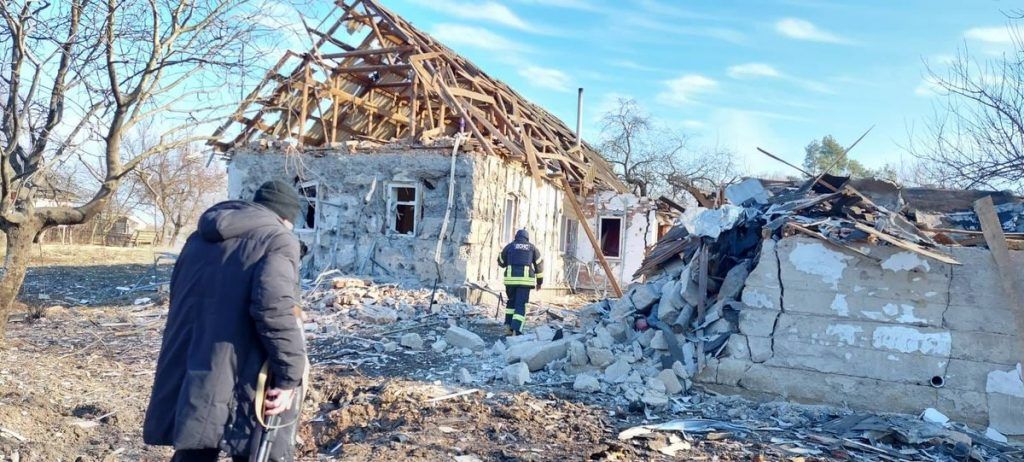Cluster bombs can harm Ukrainians long after the shelling has stopped
By Jessica McKenzie | February 28, 2022
 Buildings in the village of Pavlivka, in northwestern Ukraine, destroyed by shelling. (Photo: Official Twitter-page of Ministry of Internal Affairs of Ukraine)
Buildings in the village of Pavlivka, in northwestern Ukraine, destroyed by shelling. (Photo: Official Twitter-page of Ministry of Internal Affairs of Ukraine)
There have been multiple verified reports that Russia is using cluster munitions in its war on Ukraine from sources including the New York Times, Human Rights Watch, Bellingcat, and Amnesty International, and as the conflict continues, the number of confirmed uses of cluster munitions is likely to grow. One struck near a hospital in Vuhledar in the Donetsk Oblast (province) on February 24, killing four civilians and injuring another 10 people, including six healthcare workers. Another landed on a nursery and kindergarten in Okhtyrka, in northeastern Ukraine, on February 25 killing three civilians, including a child.
Amnesty International also said the latter attack might constitute a war crime, for violating the prohibition on indiscriminate attacks and for damaging a school.
“There is no possible justification for dropping cluster munitions in populated areas, let alone near a school,” said Agnès Callamard, Secretary-General of Amnesty International. “This attack bears all the hallmarks of Russia’s use of this inherently indiscriminate and internationally-banned weapon and shows flagrant disregard for civilian life.”
Even as Ukrainian and Russian officials met at the Ukraine-Belarus border for peace talks on Monday, Russia launched rocket strikes on Kharkiv, Ukraine’s second-largest city, which may have included cluster munitions. Mark Hiznay, associate director of the arms division at Human Rights Watch, reviewed videos of the shelling and confirmed as much to the Washington Post. “This attack clearly illustrates the inherently indiscriminate nature of cluster munitions and should be unequivocally condemned,” Hiznay said.
The attack Monday killed dozens of people, according to Ukrainian officials.
Indications that in the middle of peace talks Russia dropped a bunch of cluster muntions on civilians in Kharkiv. https://t.co/5yxhH3BTaA
— Eliot Higgins (@EliotHiggins) February 28, 2022
#Russia cluster munitions being dropped on #Kharkiv, a city of 1.4 million people.
Appalling.pic.twitter.com/UnamSTlJQS
— Charles Lister (@Charles_Lister) February 28, 2022
On Sunday, Ukraine’s health ministry estimated 352 civilians, including 14 children, have been killed in the war. Official figures by the United Nations lag behind (the UN confirmed 64 deaths on Saturday), but UN officials expect the real casualty numbers to be much higher, pending confirmation.
https://twitter.com/jscros/status/1498285686977441795
Since 2010, when the Convention on Cluster Munitions went into effect, cluster munitions have been widely banned around the globe, but Russia and Ukraine are not among the 110 countries that have signed the treaty. (Neither has the United States, for the matter.)
Cluster munitions are a type of weapon meant to break open in the air and scatter smaller explosives or “bomblets” over a wide area. They have been criticized for the indiscriminate damage they cause to people and to the environment.
According to the Red Cross, the bomblets fail to explode on contact anywhere from 10 to 40 percent of the time. That means they can have a destructive impact long after the fighting has moved on. Unexploded ordnance is obviously a risk to civilians. The bomblets might appear to be small balls or attractive toys for children to play with; between 2010 and 2014, children under the age of 18 accounted for half of all cluster munitions casualties where victim details were known.
The mere presence of unexploded ordnance from cluster munitions can cut people off from natural resources, with cascading impacts. “[F]ear of the cluster munitions denied access to abundant natural resources and arable land; populations were forced to move preferentially into secondary and fragile locations in order to avoid the unexploded ordnances,” wrote two scholars studying the impacts of cluster munitions in Lebanon. “This migration speeds depletion of biological diversity, since it disturbs essential soil and water processes and causes an acceleration of ecosystem disruption and land degradation.”
Unexploded or partially exploded munitions can also contaminate water and soil with toxic chemicals.
Both the Russian-backed separatists and the Ukrainian government have used cluster munitions in the conflict in eastern Ukraine that began in 2014, according to Human Rights Watch. Between July 2014 and February 2015, at least 31 deaths, including the deaths of two children, were attributed to cluster munitions.
Together, we make the world safer.
The Bulletin elevates expert voices above the noise. But as an independent nonprofit organization, our operations depend on the support of readers like you. Help us continue to deliver quality journalism that holds leaders accountable. Your support of our work at any level is important. In return, we promise our coverage will be understandable, influential, vigilant, solution-oriented, and fair-minded. Together we can make a difference.
Keywords: Russia-Ukraine, Ukraine, Ukraine conflict, environmental impacts of war
Topics: Climate Change, Nuclear Risk















Of course the US hasn’t signed the treaty. I once heard the US defined as a corporation with its own military.
A very insightful contribution dealing with the banned weapons used by the belligerents since 2014 in the context of the Ukraine conflict and simultaneously highlighting inherently the shortcomings of the implementation of the International Humanitarian law inside Europe.It would have been more informative if the author had outlined more broadly the motives conducive to the adoption of the convention on cluster munitions,the previous conflicts sparking their use and what are the great powers refraining from the adoption of the convention.